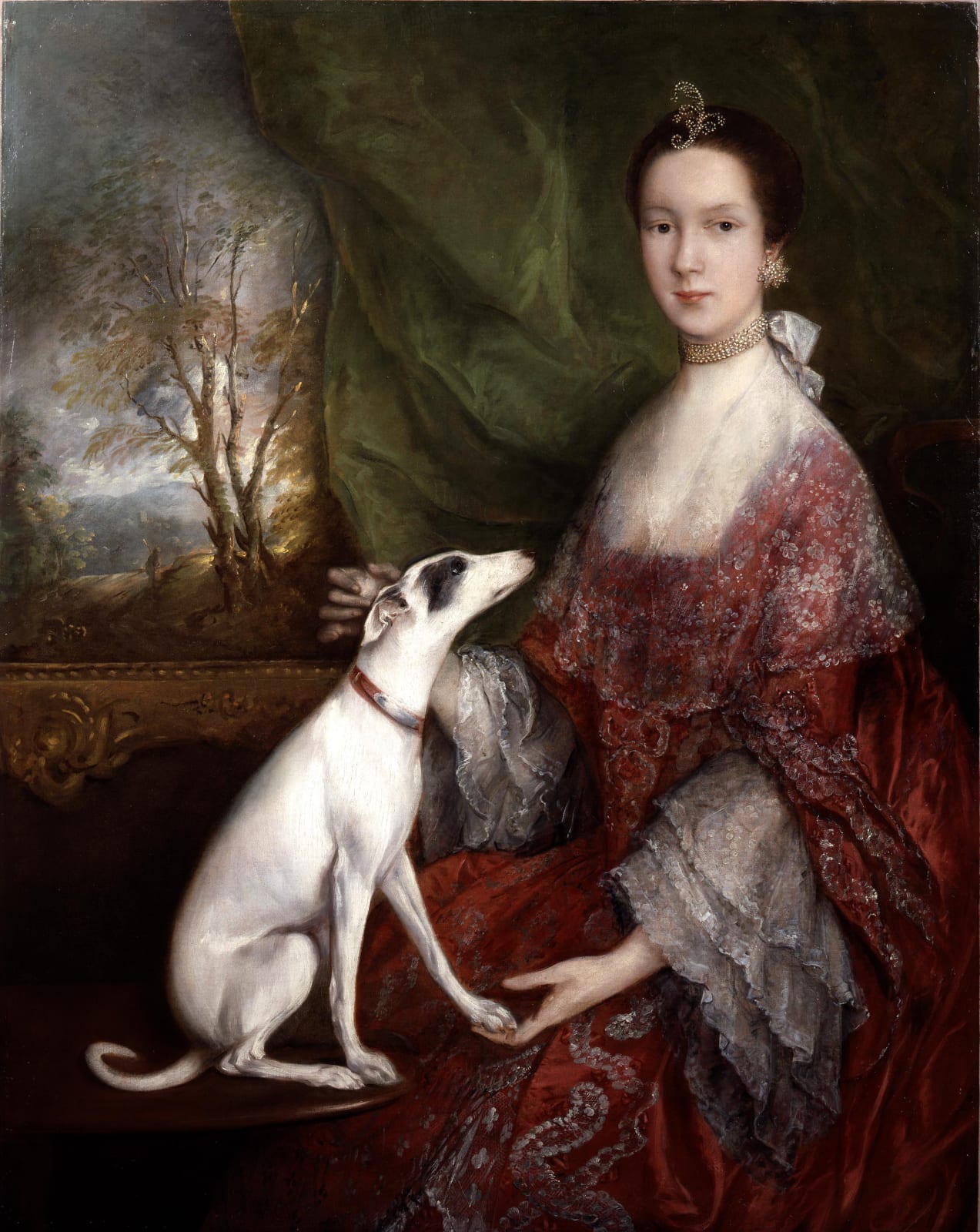
Thomas Gainsborough RA
Portrait of Elizabeth Jackson, Mrs Morton Pleydell, c. 1760
Oil on canvas
49 x 39 in (125.4 x 99 cm)
Philip Mould & Co.
To view all current artworks for sale visit philipmould.com This outstanding portrait of Miss Elizabeth Jackson, later Mrs Morton Pleydell ingeniously combines three disparate genres: landscape, portrait and animal...
To view all current artworks for sale visit philipmould.com
This outstanding portrait of Miss Elizabeth Jackson, later Mrs Morton Pleydell ingeniously combines three disparate genres: landscape, portrait and animal painting. As such it ranks amongst Gainsborough's most ambitious works at the outset of his career in the early 1760s.
This portrait has been dated to circa 1760, a year after the twenty-two year old artist moved from his native Suffolk to Bath. As Waterhouse points out his chief aim in portraiture during the next few years was to try to graft all the elegance he could learn from Van Dyck on to his native, informal style.[2]
Hugh Belsey, writing about this charming portrait of Elizabeth Jackson in 1990 has said:
'The sitter is shown in an interior stroking a greyhound, her crimson dress starkly contrasted against the green drapery behind her. To her left is a framed landscape painting; it replaced a window which must have led the beholder's eye out of the composition too rapidly. Gainsborough no doubt included landscape paintings in the background of some of his portraits at this date to advertise his own versatility.'
Stylistic details, such as Mrs Morton Pleydell's dress on the right, show how closely Gainsborough was then looking at the work of the 17th century Flemish painter Sir Anthony van Dyck. Much of Gainsborough's career in Bath was spent assimilating the lessons learned from the old masters he studied in the collections around the city.
An elaborate portrait such as this would have offered something of an advertisement for Gainsborough, conveying the young artist's diverse and skilful talents to the fashion-conscience Bath public. The handling of the drapery, in particular the lace in her upper bodice, is later seen in such masterpieces as Countess Howe (Kenwood House); the mature romantic landscape is typical of many of those produced over the next decade, notably close to rustic woodland scenes executed around Bath; the dog, probably a greyhound, exemplifies his inventive, naturalistic approach in which nature in all its forms amplifies the personality of the sitter. This reaches its zenith in his later works, particularly in the late landscapes, where the handing of animals and people and the landscape itself is indistinguishable and the whole is melded in harmony by the same dynamic brushwork.
1. Waterhouse, Gainsborough, 1958, p.85. Ibid., p. 20.
2. Hugh Belsey, Gainsborough's House promotional brochure, April to June 1990.
This outstanding portrait of Miss Elizabeth Jackson, later Mrs Morton Pleydell ingeniously combines three disparate genres: landscape, portrait and animal painting. As such it ranks amongst Gainsborough's most ambitious works at the outset of his career in the early 1760s.
This portrait has been dated to circa 1760, a year after the twenty-two year old artist moved from his native Suffolk to Bath. As Waterhouse points out his chief aim in portraiture during the next few years was to try to graft all the elegance he could learn from Van Dyck on to his native, informal style.[2]
Hugh Belsey, writing about this charming portrait of Elizabeth Jackson in 1990 has said:
'The sitter is shown in an interior stroking a greyhound, her crimson dress starkly contrasted against the green drapery behind her. To her left is a framed landscape painting; it replaced a window which must have led the beholder's eye out of the composition too rapidly. Gainsborough no doubt included landscape paintings in the background of some of his portraits at this date to advertise his own versatility.'
Stylistic details, such as Mrs Morton Pleydell's dress on the right, show how closely Gainsborough was then looking at the work of the 17th century Flemish painter Sir Anthony van Dyck. Much of Gainsborough's career in Bath was spent assimilating the lessons learned from the old masters he studied in the collections around the city.
An elaborate portrait such as this would have offered something of an advertisement for Gainsborough, conveying the young artist's diverse and skilful talents to the fashion-conscience Bath public. The handling of the drapery, in particular the lace in her upper bodice, is later seen in such masterpieces as Countess Howe (Kenwood House); the mature romantic landscape is typical of many of those produced over the next decade, notably close to rustic woodland scenes executed around Bath; the dog, probably a greyhound, exemplifies his inventive, naturalistic approach in which nature in all its forms amplifies the personality of the sitter. This reaches its zenith in his later works, particularly in the late landscapes, where the handing of animals and people and the landscape itself is indistinguishable and the whole is melded in harmony by the same dynamic brushwork.
1. Waterhouse, Gainsborough, 1958, p.85. Ibid., p. 20.
2. Hugh Belsey, Gainsborough's House promotional brochure, April to June 1990.
Provenance
By descent to Sir Harold Lister Farquhar (1894-1953) His sale, Sotheby's, 13 December 1950, Lot.2 The property of the purchaser until 1995Exhibitions
On loan to Gainsborough's House, Sudbury, 1990.Literature
Ellis Waterhouse, Gainsborough, London, 1958, Cat.no.549, p.85.Hugh Belsey, Gainsborough's House Quarterly, 1990.